Thick as Mud

Cover Image: Sasha Wortzel, Sitting
Shiva [detail], 2020 Burmese Python skin, vegetable-tanned hide, aluminum, plastic. Installation view of Thick as Mud, 2023.


Cover Image: Sasha Wortzel, Sitting
Shiva [detail], 2020 Burmese Python skin, vegetable-tanned hide, aluminum, plastic. Installation view of Thick as Mud, 2023.
Diedrick Brackens
Ali Cherri
Christine Howard Sandoval
Candice Lin
Rose B. Simpson
Eve Tagny
Sasha Wortzel FEB

Thick as Mud explores how mud animates relationships between people and place through the work of eight contemporary artists. Across multiple geographies and a range of aesthetic approaches—from figurative clay sculpture to audio recordings of the swamp—these artists engage mud as a material or subject that shapes personal and collective histories, memory, and imagination. Each artist brings a distinct perspective to the theme, conjuring dynamics embedded in the landscape that include colonial and racialized forms of dispossession, cultural reclamation, narratives of self-actualization, and ecological loss and adaptation.
Mud moves through the exhibition as a metaphor as well as a tangible material. Both water and earth, mud exists in an in-between state. A medium that dissolves binaries, mud invites a blurring of past and present, personal and political, bodies and landscape, feeling and knowing. In various ways, the artworks in Thick as Mud move across these porous boundaries, disrupting linear narratives and dominant hierarchies that shape which places and stories matter.
Across the artworks, mud becomes an agent of time and transformation and a medium of decomposition and creation. As such, Thick as Mud tracks the afterlives of violence against people and the environment while also evoking the potential for regeneration. The exhibition is an invitation to ask what lives in the mud and to reconnect with the possibilities for knowing differently that this material holds.
— NINA BOZICNIKInstallation view of Thick as Mud, 2023. Foreground: Rose B. Simpson; Background: Diedrick Brackens.

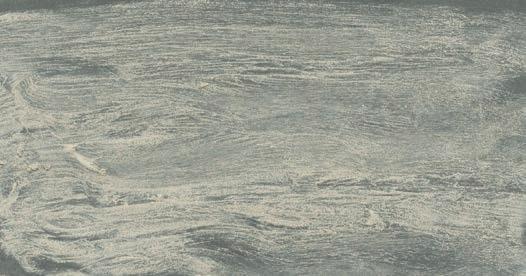
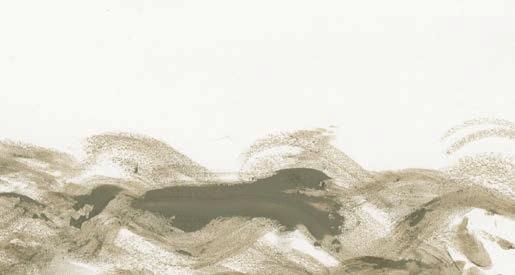
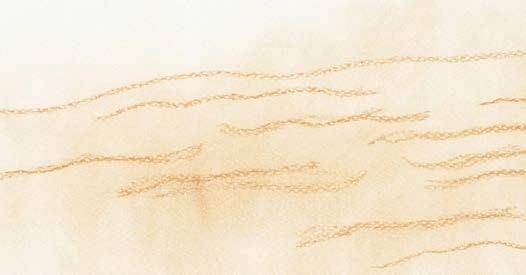
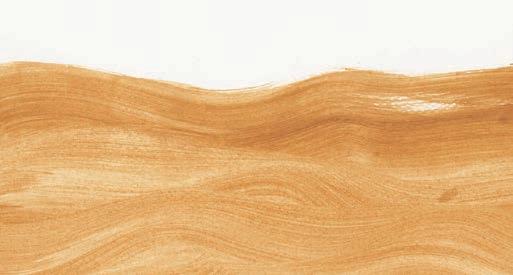
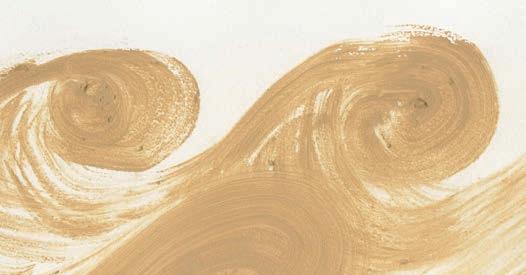
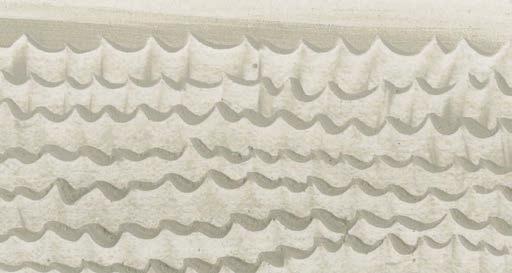
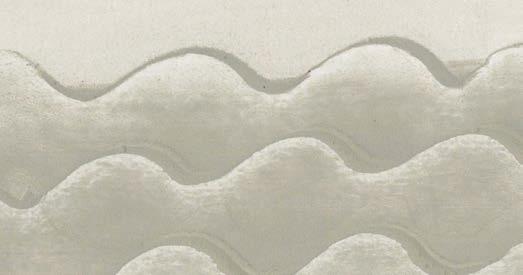
born 1981, Polokwane, South Africa; lives in Johannesburg, South Africa
Dineo Seshee Bopape examines personal, collective, and planetary memory across a practice that includes video, sound, light, and elemental matter like soil, crystals, and herbs. She combines materials in alchemical ways, creating works that address the residual wounds of historical trauma inflicted by racial and colonial violence against people and the Earth.
Bopape’s immersive installation, Master Harmoniser (ile aye, moya, là, ndokh), is an animated video and sound environment made from soil and water collected from places that played historical roles in the transatlantic slave trade: Virginia, Louisiana, Senegal, Ghana, and South Africa. Bopape’s dizzying animation conjures the memory of enslavement and forced migration that connects these dispersed places across time and geography.
The tactile, visual marks that comprise the animation are a response to widely circulated abolition-era images depicting the heavily scarred back of a formerly enslaved man in Louisiana,
known as either Peter or Gordon. Sounds of water, wind, human cries, and music accompany the imagery and amplify the dislocation, horror, and resistance that Peter’s story of enslavement and escape embodies. Bopape titled this work ile aye, moya, là, ndokh—the four elements (earth, wind, fire, and water) in four different African languages (Yoruba, Nguni/Sepedi, Ga, and Wolof, respectively)—conjuring the multivocal tongue spoken by the African diaspora and the relationship of ancestral memory to other potent, foundational life forces.
Mud from Pacific Northwest waterways covers the walls in the Henry installation, inviting viewers to recollect relationships between this region and global histories. The story of Charles Mitchell, an enslaved boy in Washington Territory who escaped to freedom in British Columbia in September 1860, appears as a footnote in the history of the Pacific Northwest, but is revelatory of the region’s entangled history with slavery, Black disenfranchisement, and resilience.
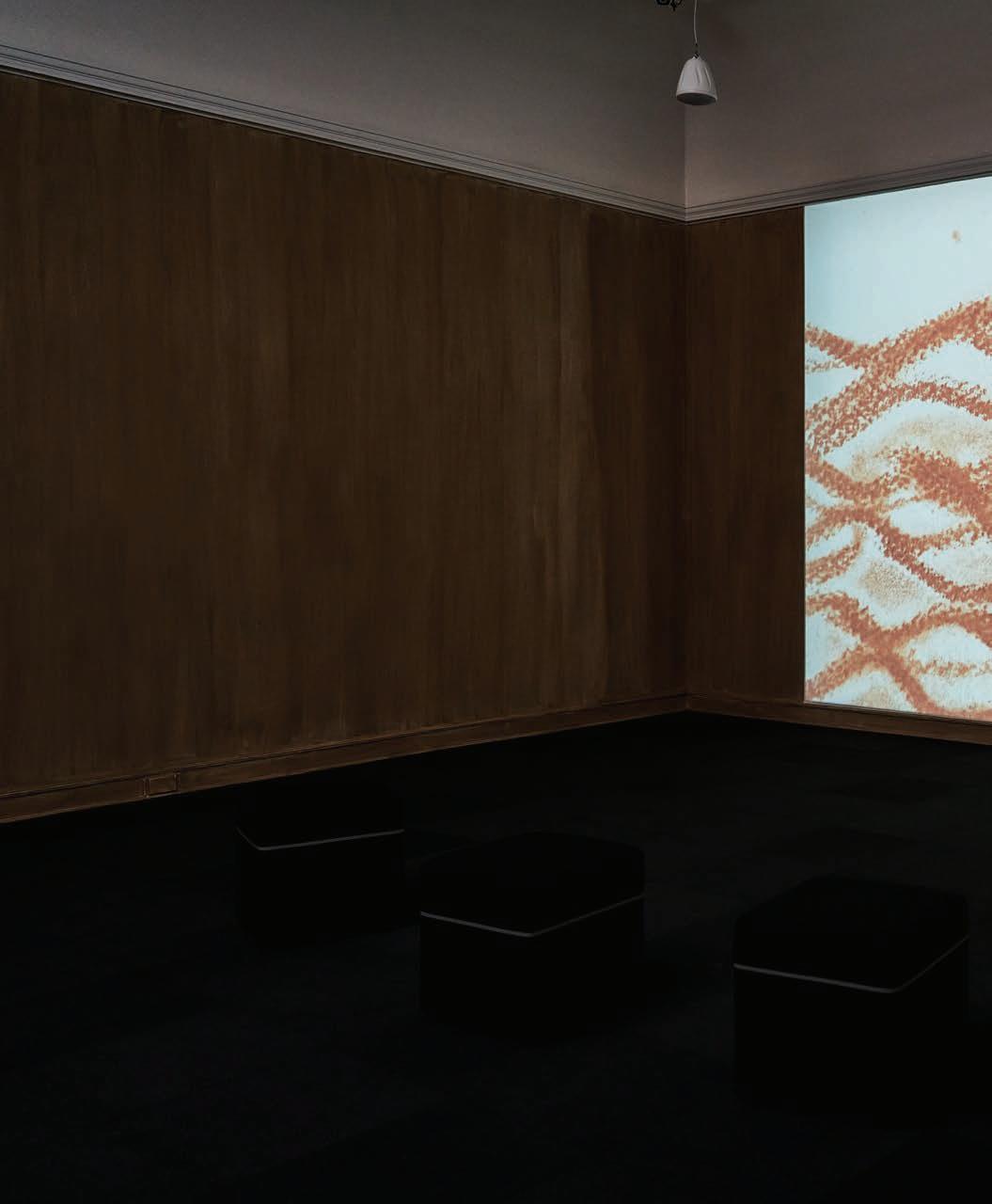 Dineo Seshee Bopape, Master Harmoniser (ile aye, moya, là, ndokh), 2021. Digital animation (color, sound); 25:08 mins. Installation view of Thick as Mud, 2023.
Dineo Seshee Bopape, Master Harmoniser (ile aye, moya, là, ndokh), 2021. Digital animation (color, sound); 25:08 mins. Installation view of Thick as Mud, 2023.
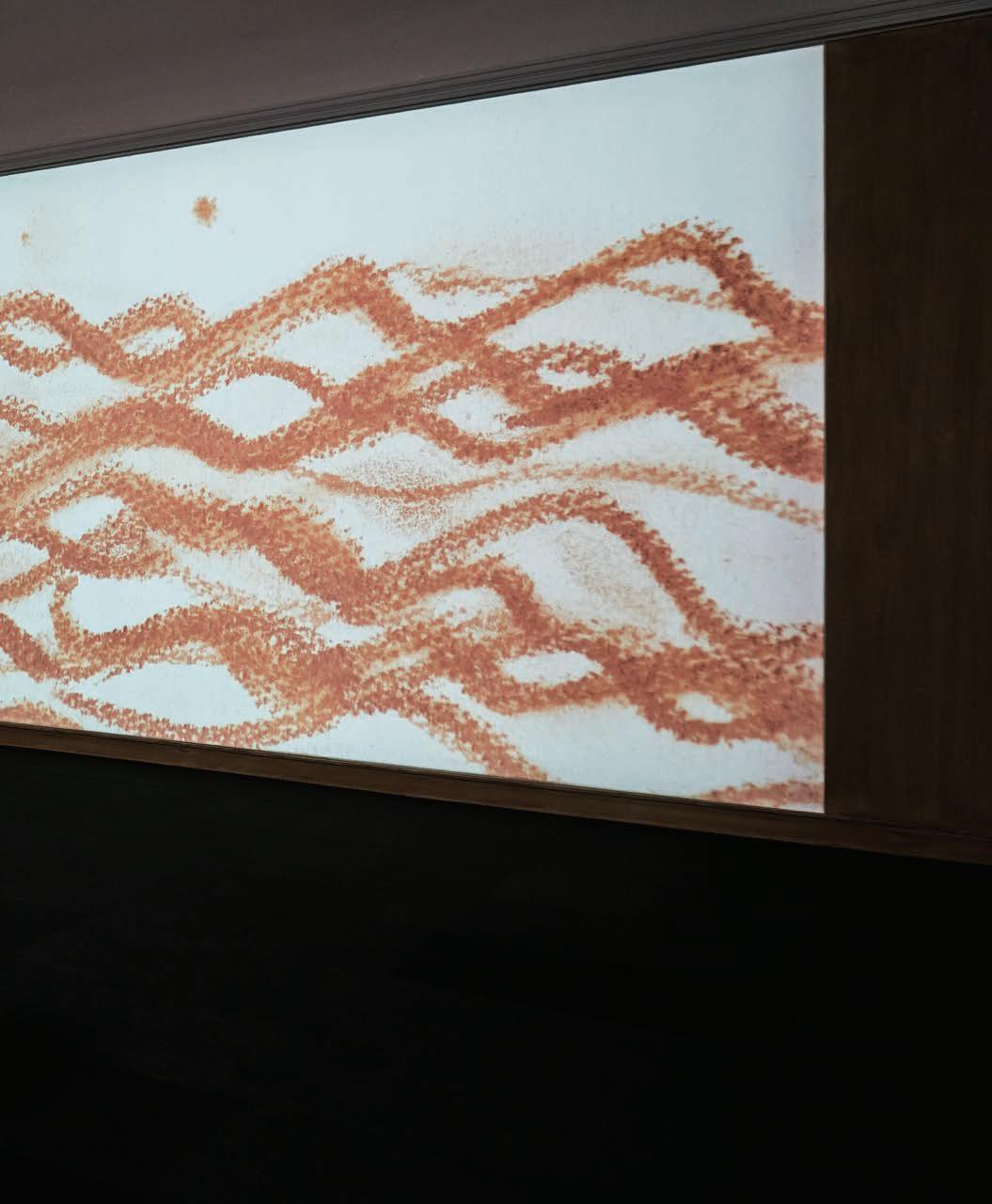
born 1989, Mexia, Texas; lives in Los Angeles, California
Diedrick Brackens engages questions of history and identity through weaving. Brackens sees the loom as a “space of invention,” creating narrative textiles that draw on a global range of traditions from Flemish tapestry to Ghanaian kente cloth to American quilting.1 Brackens has created a uniquely hybrid visual language and personal mythology that speaks to his own identities as a queer, Black, Southern man. Working primarily with cotton, his work gestures toward the violent histories of slavery inextricably tied to this material in the United States, while his recuperation of cotton as a medium of personal expression is an act of self-determination and healing.
Catfish are a recurring motif in Brackens’s work. Catfish are muddwelling bottom feeders often perceived as dirty or undesirable whom Brackens recasts as exalted creatures that provide both psychic and physical nourishment. In his work, catfish
act as agents of transformation and spiritual transcendence. Catfish first appeared in his work as an allegorical figure for three young Black men who drowned in Lake Mexia in Texas while in police custody on Juneteenth 1981—a story of local racial violence often retold to Brackens by his mother and grandmother. Over time, catfish have taken on a broader meaning in Brackens’s work, serving as a symbol of Black Southern culture—catfish are a staple of much regional cuisine—and as a representation of Brackens himself and, more expansively, as a reference to the soul or ancestral spirits.
1The Mint Museum, “Diedrick Brackens: Ark of the Bulrushes,” YouTube video, 7:33 mins., July 5, 2022. https://youtu.be/bMDOcxD_AI4.
Diedrick Brackens, maximum depth, 2020. Cotton and acrylic yarn. Courtesy of the artist and Various Small Fires, Los Angeles/Dallas/Seoul.

born 1976, Beirut, Lebanon; lives in Paris, France
Ali Cherri’s work across film and sculpture investigates histories of nation-building, political ecologies of place, and legacies of trauma, especially in the context of the Arab world. In particular, Cherri challenges dominant narratives of social and cultural progress that often conceal harm against people and the environment.
Of Men and Gods and Mud is a threechannel video installation that traces the central role of mud and floods in creation myths from around the globe, and in the labor and lives of seasonal mud-brick workers in northern Sudan. In the film, Cherri attends to the way the construction of the Merowe Dam in the region has disrupted the Nile River’s natural flow and dramatically reshaped the local landscape, displacing many
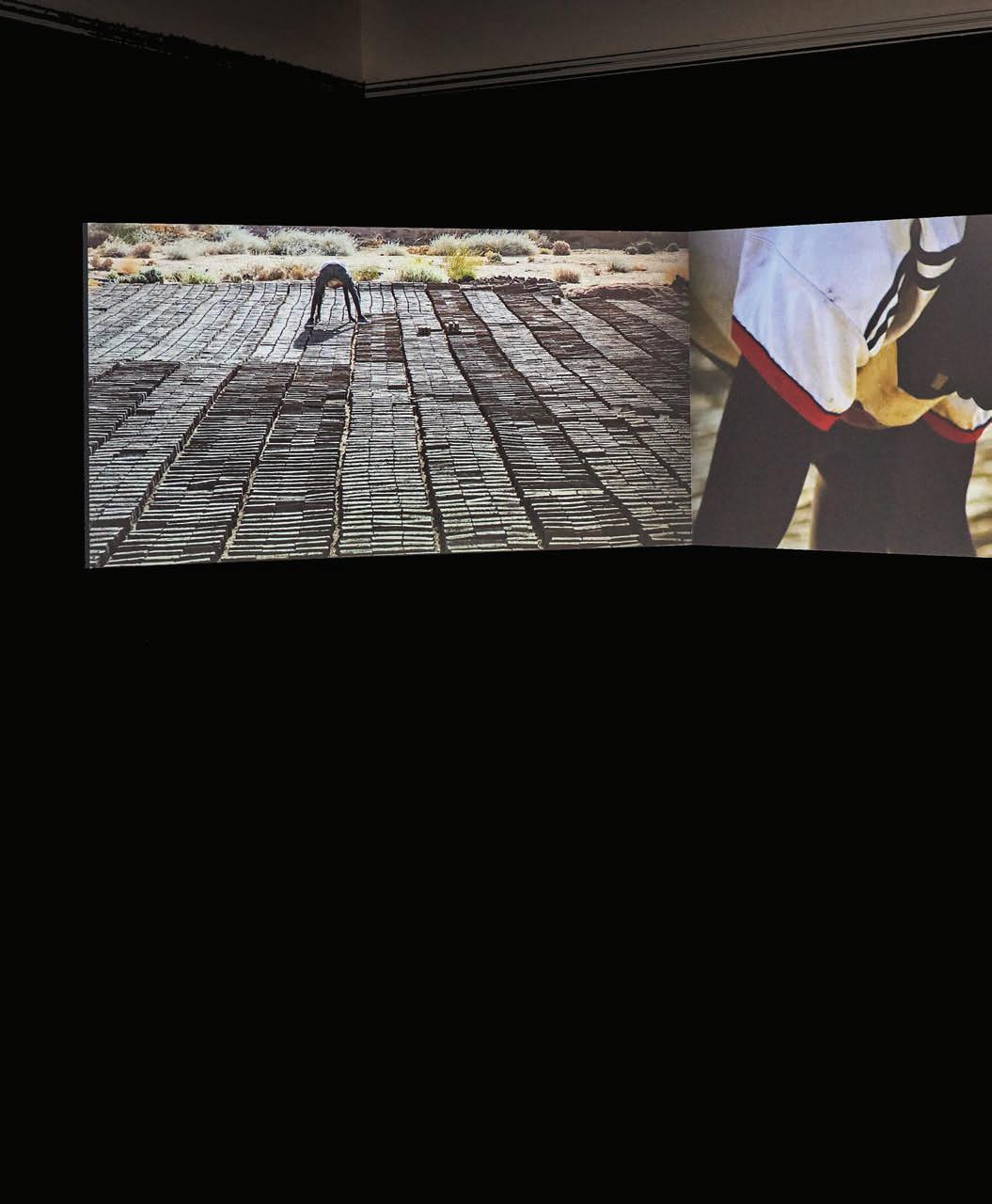
people from the fertile Nile Valley to arid desert lands. In the past, annual flooding shaped the region through regular cycles that left fertile silt deposits in the path of receding waters. With the start of construction on the Merowe Dam in the early 2000s, this natural cycle ceased. The inundation of water buried local villages in unabated depths, and the river now flows at the command of political and economic
power. In the film, Cherri contrasts the forces of state and capital with the individual lives of regional laborers who, like the land, are subject to the authority of these forces.
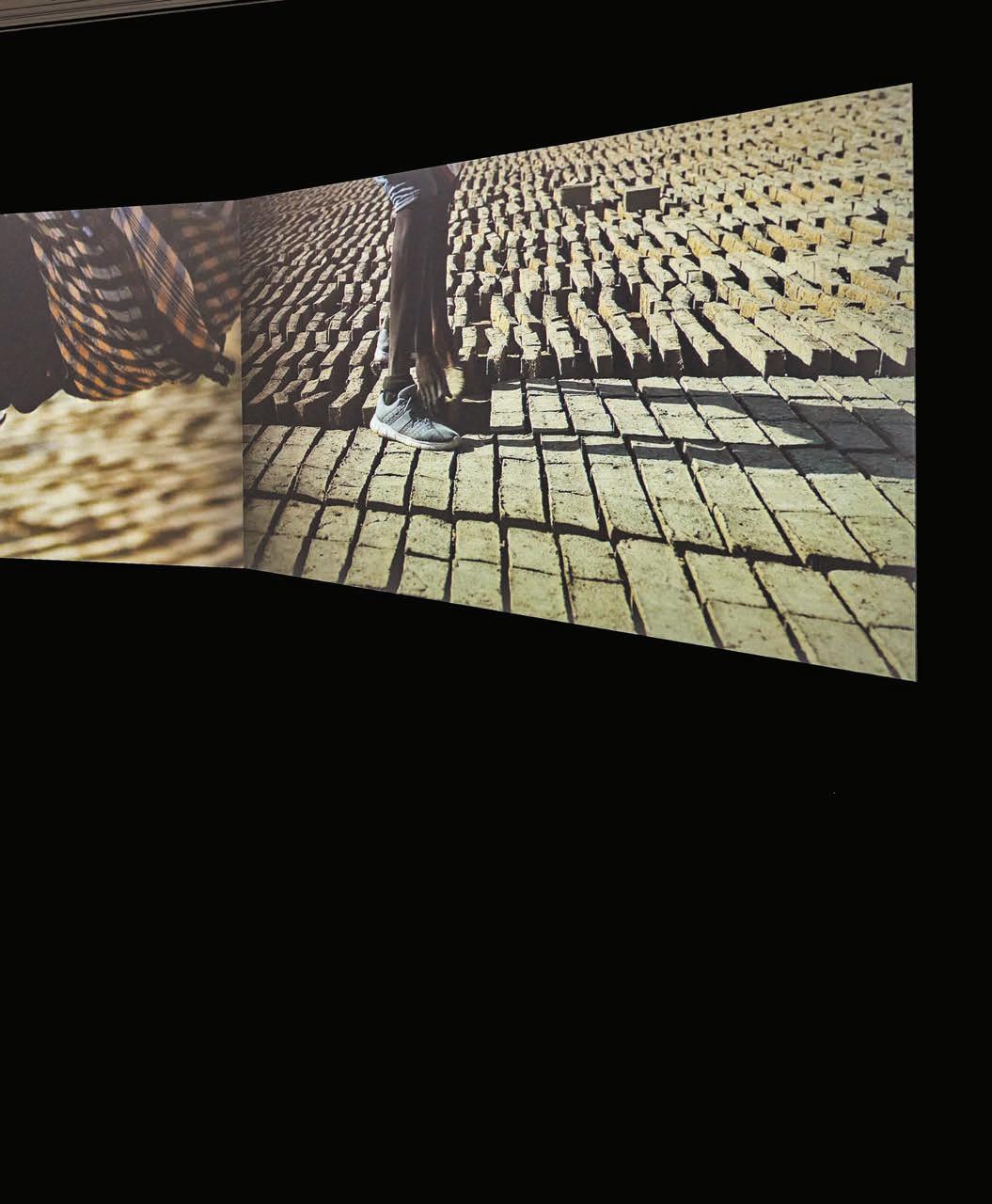 Ali Cherri, Of Men and Gods and Mud, 2022. Three-channel video installation (color, sound); 18:30 mins. Installation view of Thick as Mud, 2023.
Ali Cherri, Of Men and Gods and Mud, 2022. Three-channel video installation (color, sound); 18:30 mins. Installation view of Thick as Mud, 2023.
The Inca, the Maori, the Babylonians, the Egyptians, the Chinese, the Hindus, the Yoruba, the Sumerians. Seas and mountains and years apart and yet they all told the same story: man out of mud.
And, indeed, We created man from an extract of clay. Out of mud we first made. Out of mud we dreamed we were made. Then we forgot, or sought to forget, and declared ourselves the makers.


Candice Lin traces legacies of colonialism and diaspora through the history of physical materials, often making associative links across time, place, and subject. Swamp Fat is an installation of ceramic frogs, snakes, and lizards that contain solid perfume made from animal lard infused with the smell of rotting vermin. This work emerged from Lin’s investigations into cultural perceptions around contamination in relation to the construction of race and citizenship within the bayous of Louisiana in the eighteenth and nineteenth centuries.
Lin’s ceramic vessels are made of clay collected from near St. Malo, Louisiana, thought to be the site of the first Asian American settlement in the United States, and which was previously inhabited by escaped slaves and Indigenous peoples. Established by escaped Filipino indentured laborers in the mid-eighteenth century, St. Malo existed in the swamp, protected from the reach of government officials. Set atop ornate pedestals made from scagliola, a faux marble decoration popular in seventeenth-century Italian
architecture, Lin’s creaturely vessels honor the swamp and the community who made a life there beyond the restrictions of white society.
Inside the ceramic vessels, Lin’s wearable perfume emits an odor of rot, interrogating social fears of pestilence and impurity that have historically been associated with racialized bodies. The animal fat used to make the perfume conjures additional associations, including the Slaughterhouse Cases brought before the U.S. Supreme Court in 1873. Precipitated by the issue of animal waste polluting the Mississippi River, alongside questions of labor and property rights, the case ultimately resulted in a decision that severely restricted the Fourteenth Amendment, disempowering newly free Black Americans whom the amendment was originally intended to protect.

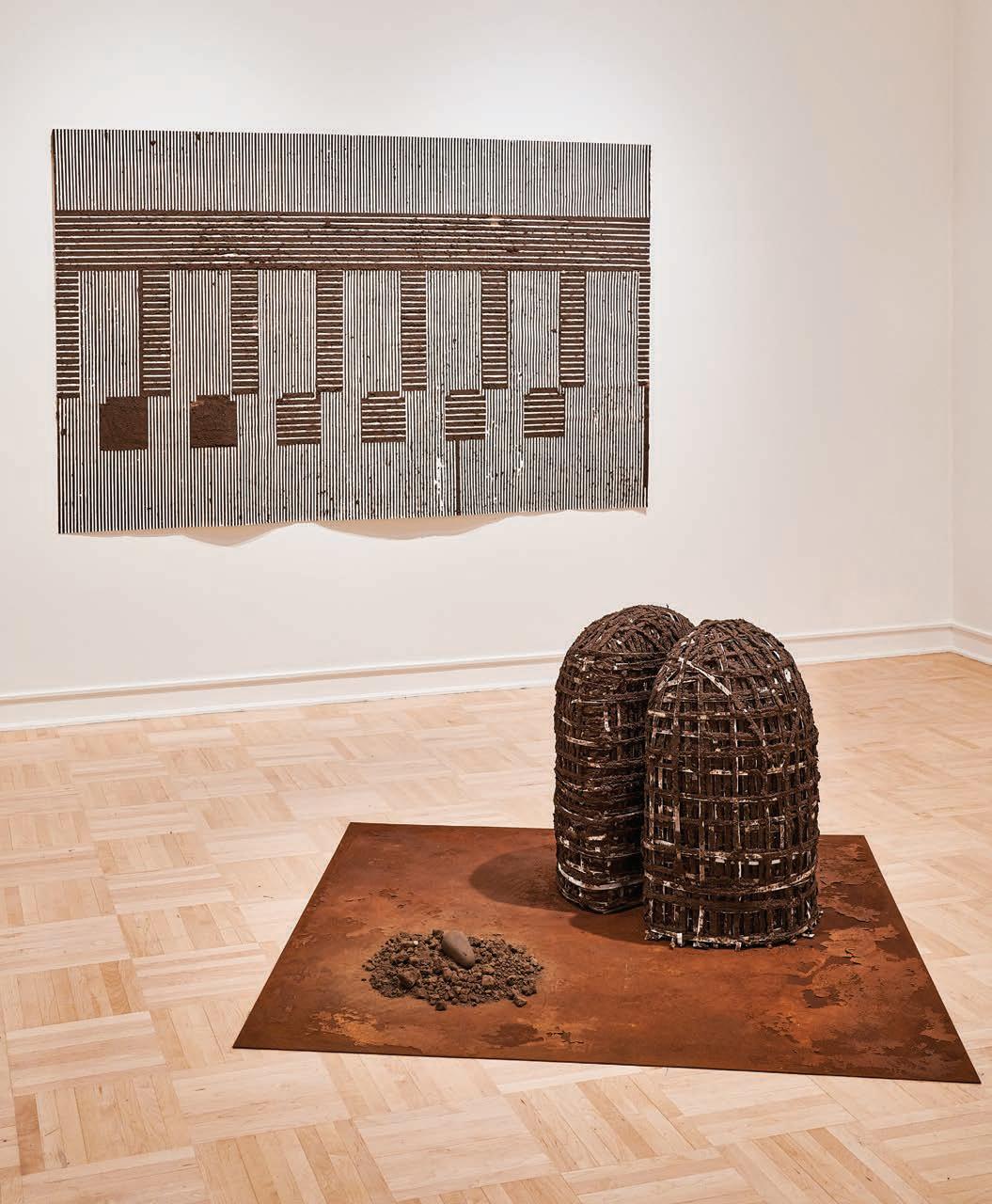 Installation view of Thick as Mud, 2023. Christine Howard Sandoval.
Installation view of Thick as Mud, 2023. Christine Howard Sandoval.
born 1975, Anaheim, California; lives in Vancouver, British Columbia
Christine Howard Sandoval investigates colonial histories of inhabitation and displacement through the lens of her own relationship to land, language, cultural memory, and architecture. Her recent body of work explores the historical uses of adobe, a desert building material made from clay, sand, and soil with close connections to her familial lineage. In the eighteenth century, Howard Sandoval’s paternal Chalon ancestors were forced from their homelands and confined to the Mission Soledad during Spanish attempts to Christianize and acculturate the Indigenous inhabitants of California. Subjugated Indigenous people built and maintained the mission using adobe, a technology introduced to the region by missionaries after their experiences with Native peoples of the Southwest. Howard Sandoval’s own use of adobe is a way to process the painful past of her paternal heritage, while also reconnecting to a material with deep ties to her maternal Hispanic ancestors from the Southwest.
In her drawings, Howard Sandoval renders the mission architecture in a simplified typology. This approach is a way to contend with the ubiquity of this architecture as uncontested symbols of California history. Using souvenir models of the missions to create her drawings, Sandoval recalls the requisite assignment of building a mission model that she and her fellow classmates completed as a part of California’s educational requirements. This educational assignment came with a total lack of tending to the colonial histories of the missions, effectively erasing Indigenous peoples from California state history. Through the embodied process of mixing and working with adobe, Howard Sandoval gives agency back to the Indigenous body, asserting a Native presence into California’s shared histories.
The companion video, Niniwas- to belong here, layers found texts and imagery with body camera footage of Howard Sandoval’s movement
through Mission Soledad, creating a form of embodied drawing through the landscape. Granted access to protected areas of the site, Howard Sandoval walks the mission grounds while tenderly touching the walls of the crumbling architecture and the artifacts of former inhabitants that she encounters there. One of these objects, a large cracked metate or stone tool used for processing grain and seed, inspired Howard Sandoval’s sculpture titled Split Metate, between two worlds, which pays homage to the memory of touch, labor, and life held in the original tool.
Christine Howard Sandoval, Niniwas- to belong here [still], 2022. Single-channel video (color, sound). Installation view of Thick as Mud, 2023.
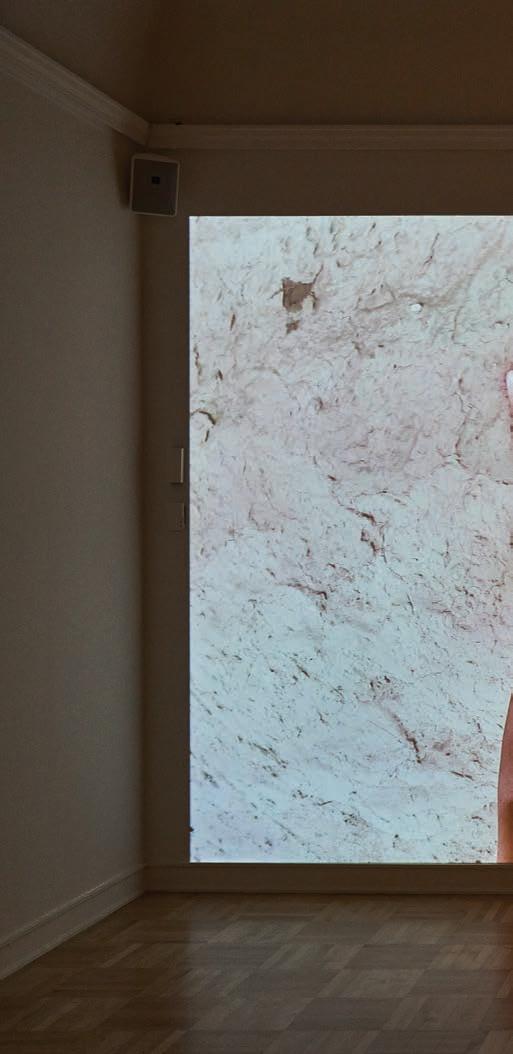
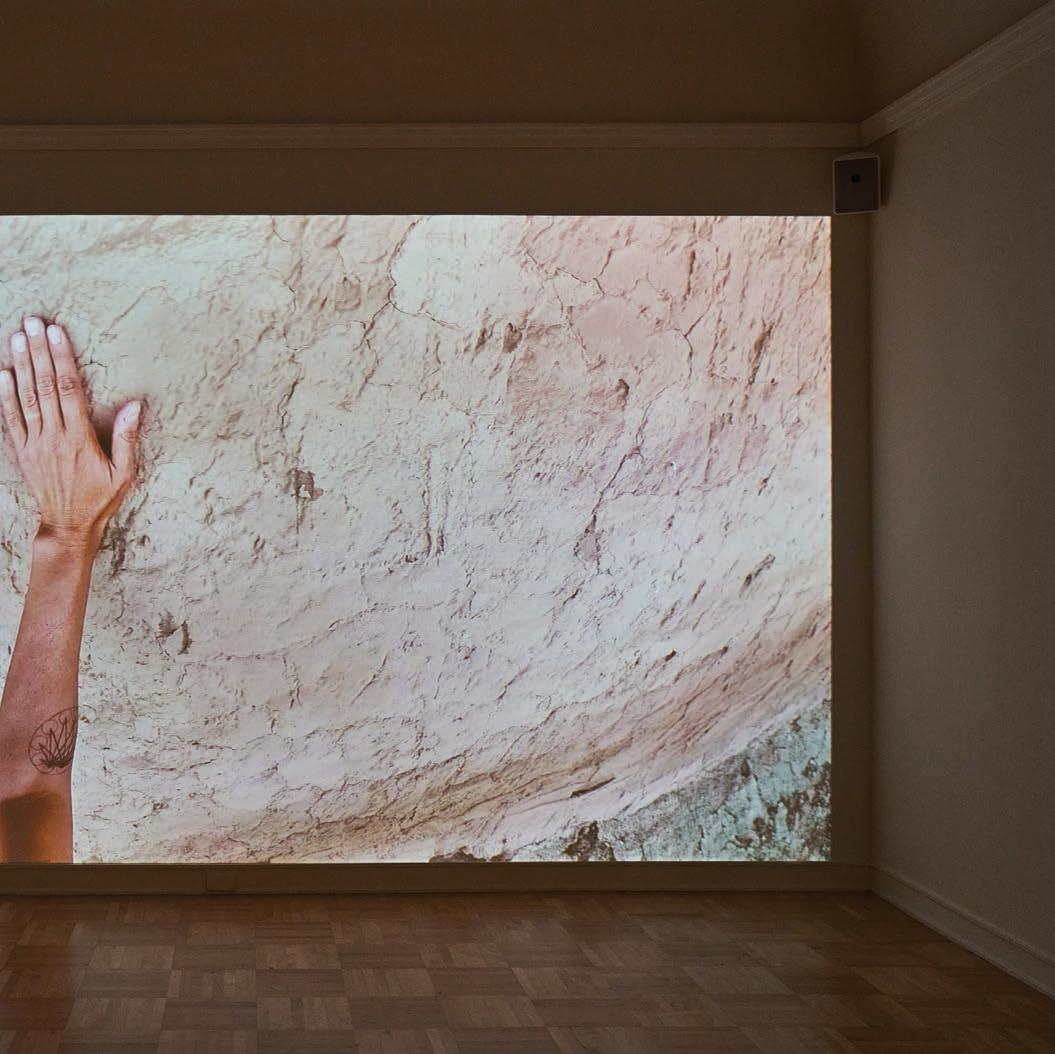
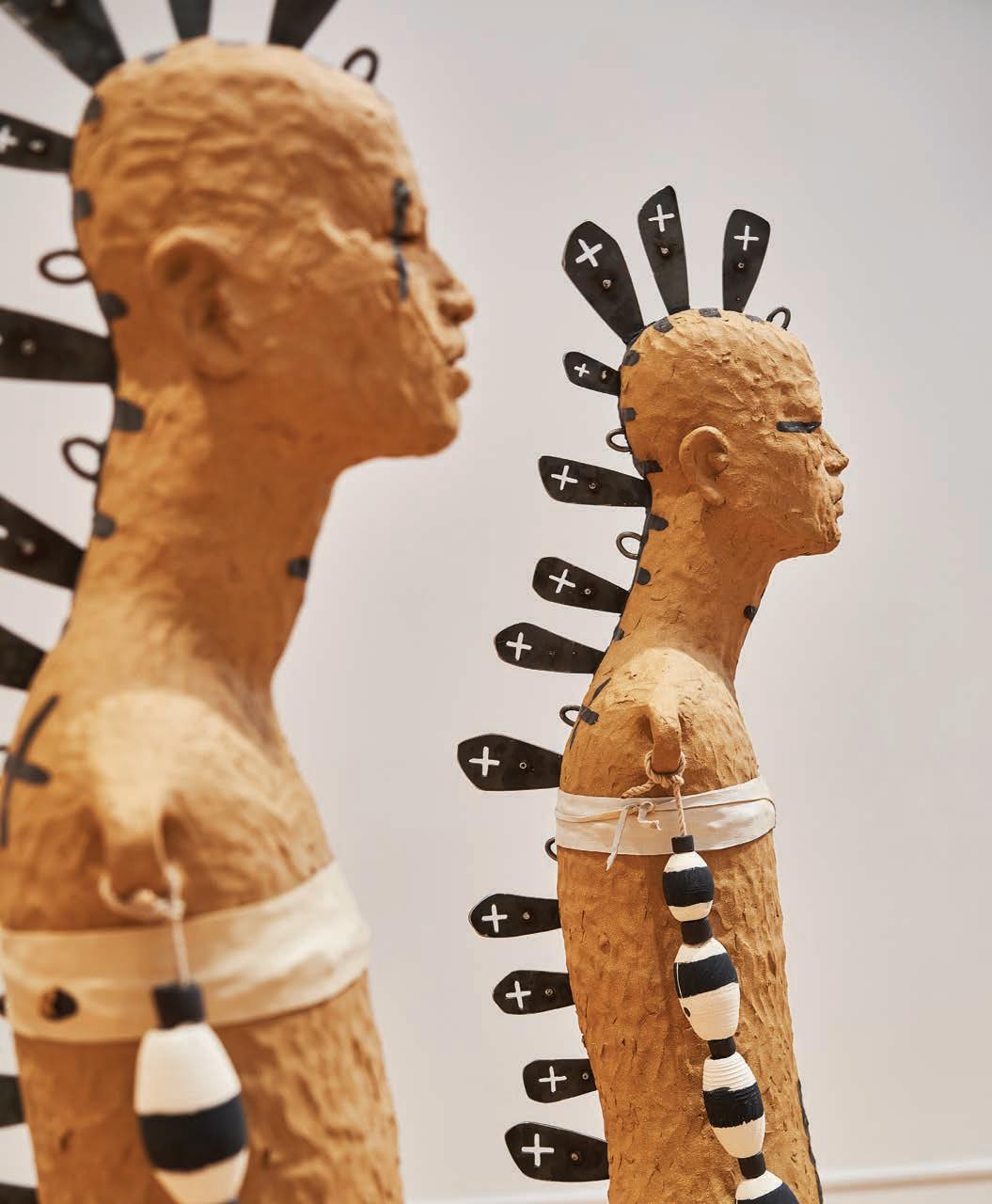
Rose B. Simpson’s work in clay draws from her Tewa ancestry as Santa Clara Pueblo and a deep matrilineal heritage of ceramic artistry. She adapts a millennia-old tradition of working with clay by inventing new techniques to make forms that respond to contemporary life and express her hopes for the world.
Simpson’s figures are powerful agents of Indigenous survival in the wake of colonial violence against Native communities and the environment. Two of these figures, River Girl 1 and River Girl A, are immortal warriors that stand ready to accompany and protect each other through battle. Adorned with metal feathers that run down their backs like spikes, prayer beads for arms, and marked with a “+”—a recurring motif for the cardinal directions and journey of life in Simpson’s work—these figures don spiritual and physical armor for moving through an inhospitable world. Simpson made these embodiments of female presence and power in direct response to the epidemic of
Missing and Murdered Indigenous Women and Girls that is taking place in the United States and Canada.1
Simpson’s figures are vessel forms built from layers of heavily worked clay. They exude a sense of strength through vulnerability, embodied in the properties of clay itself. Simpson approaches clay with almost spiritual intentions, saying, “The water in the clay is listening to my internal molecular water, so it’s going to respond and break [if I’m in an agitated state]… Whatever your intentions are, it listens and responds.”2 Understanding clay this way, Simpson treats her material as a living entity that requires humility, evoking a worldview of mutual relationship between the resources of the Earth and its human inhabitants.
12021 A + E: Clay, Place, and Cultural Survival with Rose B. Simpson,” Nevada Museum of Art, January 19, 2022, https://www.youtube. com/watch?v=4i-C7J_1N0c&t=2377s.
2Peter Relic, “Rose B. Simpson’s deFINE ‘Countdown,” SCADworks, February 26, 2021, https://www.scad.edu/blog/ rose-b-simpsons-define-countdown.

Installation views of Thick as Mud, 2023. Previous page and foreground: Rose B. Simpson; Background: Diedrick Brackens.
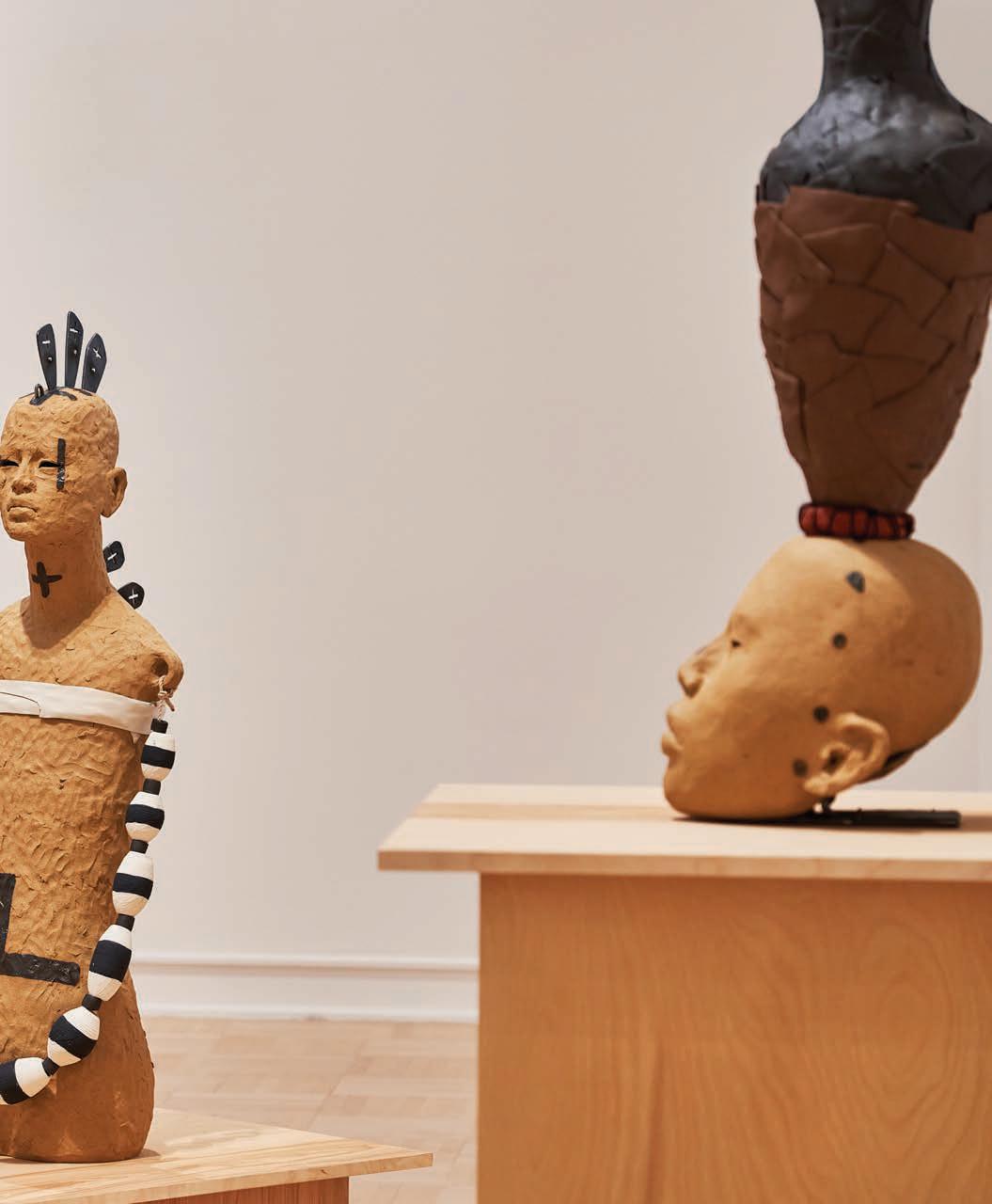
born 1986, Montréal, Québec; lives in Montréal, Québec
Eve Tagny’s work explores disrupted landscapes as sites of embodied memory. Her installation, The Carriers, brings together a selection of recent performance videos enacted within a rock quarry in Québec, the ruins of a Tuscan villa, and a construction site in a gentrifying area of Montréal. In these videos, Tagny and her collaborators perform ritual-like gestures in physical dialogue with the site itself. Bodies drape over excavated rocks at the quarry. Tagny’s own shoulder presses against a tree that has reclaimed the villa’s ruins. Hands touch a muddy stream at the construction site. These intimate gestures convey a recognition that gendered and racialized bodies, and the land, share wounds inflicted by the economic forces of extractive labor and property. In the case of the construction site, the presence of Black bodies is an act of resistance against
the ways gentrification erases the presence of racialized communities.
Tagny has set her videos within an environment of sculptural objects and architectural forms made from various construction materials, including cob—a building agent of mud and straw used in Tagny’s paternal, ancestral home of Cameroon and around the globe. Textiles installed in the space carry a residue of marks and stains of pigment made with earth and plants that Tagny collected from the construction site in Montréal and the grounds of the Tuscan villa. These textiles resonate as bodily surrogates that carry traces of history, forming tender evocations of the life that persists amid the trauma of extraction, which violates the land and the bodies of those who inhabit it.
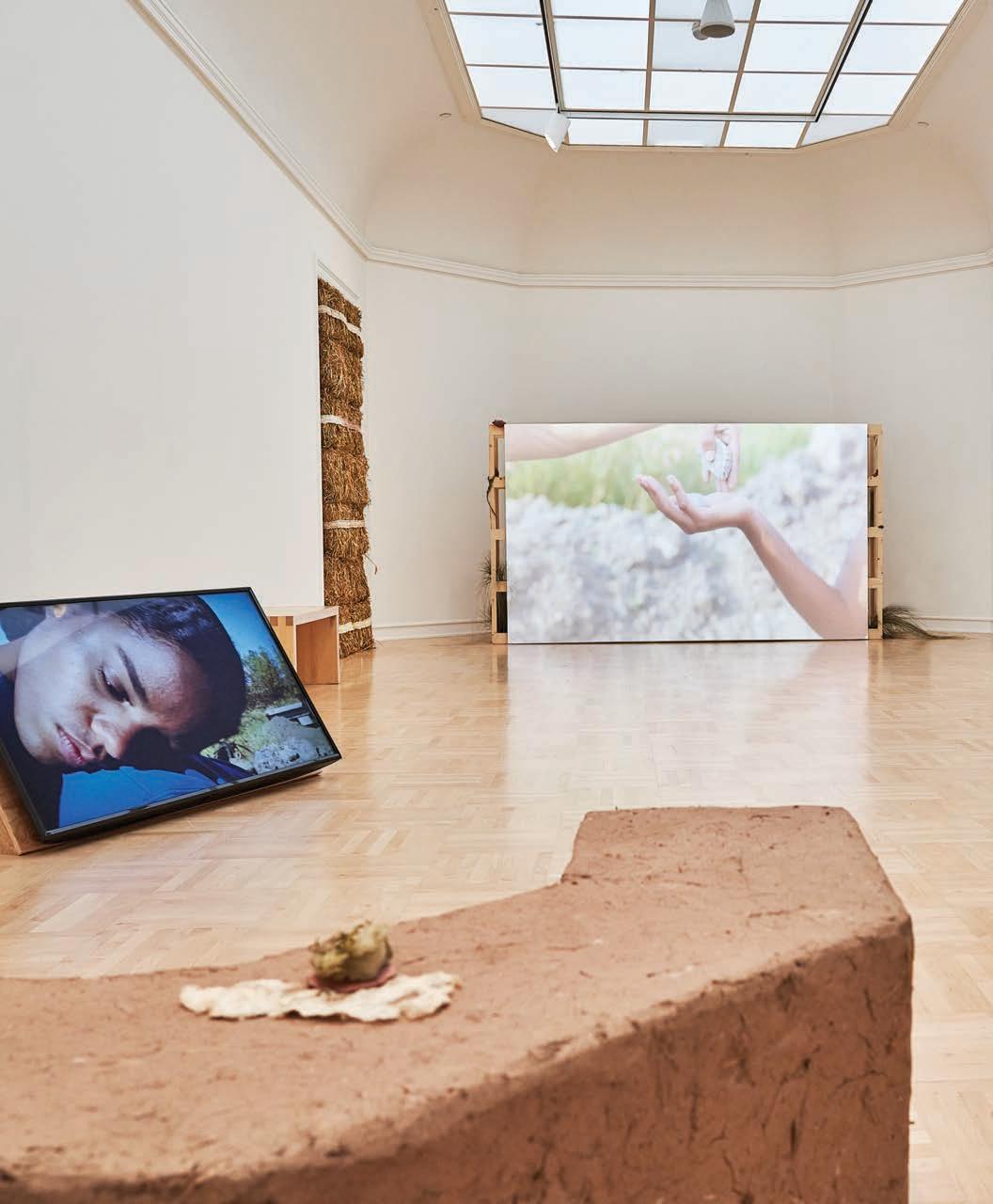
Sasha Wortzel, Sitting Shiva, 2020 Burmese Python skin, vegetable-tanned hide, aluminum, plastic. Installation view of Thick as Mud, 2023.
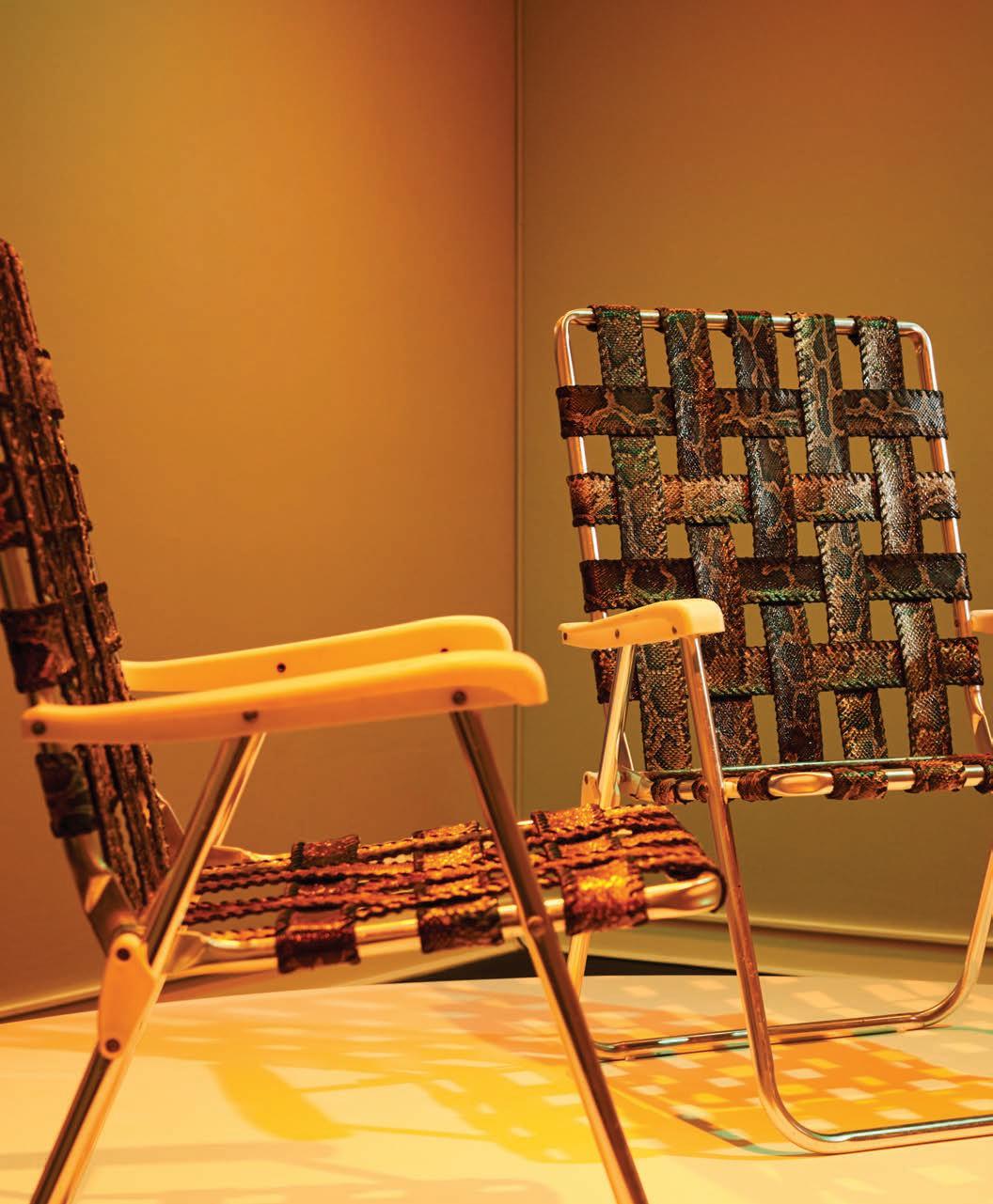
born 1983, Fort Myers, Florida; lives in Brooklyn, New York
Across film and expanded forms of cinema, Sasha Wortzel explores queer narratives and ecologies of place, with a particular focus on the social and environmental histories of South Florida, where she grew up. The tangled dynamics of desire and loss layered in that landscape form a through line in Wortzel’s work, animating the fallacies and harm of colonial conquest that reverberate across time.
Her installation for Thick as Mud is in dialogue with the changing environment of the Everglades and interdependent coastal communities. The central sculpture consists of two ordinary lawn chairs with the traditional nylon webbing replaced by the skin of Burmese python, a species that has ravaged local wildlife populations since its introduction to the area by the pet trade. Titled Sitting Shiva, a reference to the Jewish mourning ritual enacted at the time of someone’s death, Wortzel’s empty
chairs hold the memory of habitats and ways of life lost in the wake of the human-made environmental crisis. Wortzel’s reconfigured chairs interrupt traditional conceptions of a leisure lifestyle synonymous with the rapid development in South Florida, and make palpable the need for human populations to reorient their relationships to a changing environment.
Over the last century, efforts to drain the swamplands of the Everglades for agriculture and development have reengineered the workings of a vast ecosystem. In Wortzel’s installation, an immersive audio track of croaking frogs during a tropical storm resounds throughout the gallery calling forth the vitality and nourishment offered by the swamp and its waters. Wortzel makes present the life and death of an ecosystem to offer us an embodied meditation on how endings are also beginnings yet written.
Dineo Seshee Bopape (born 1981, Polokwane, South Africa; lives in Johannesburg, South Africa)
Master Harmoniser (ile aye, moya, là, ndokh), 2021
Digital animation, (color, sound); 25:08 mins. Dimensions variable
Courtesy of the artist & Sfeir-Semler Gallery, Beirut/Hamburg
Diedrick Brackens (born 1989, Mexia, Texas; lives in Los Angeles, California)
maximum depth, 2020
Cotton and acrylic yarn
81 x 80 in. (205.74 x 203.2 cm)
Collection of Michael Sherman
Diedrick Brackens
mud bright sight, 2021
Cotton and acrylic yarn, polyester
sewing thread, sewing notions
43 x 40 1/2 in. (109.22 x 102.87 cm)
Collection of Suzanne McFayden
Diedrick Brackens stud double, 2019
Cotton and acrylic yarn
72 x 72 in. (182.88 x 182.88 cm)
Collection of Allison and Larry Berg
Ali Cherri (born 1976, Beirut, Lebanon; lives in Paris, France)
Of Men and Gods and Mud, 2022
Three-channel video installation (color, sound); 18:30 mins.
Dimensions variable
Courtesy of the artist and Galerie Imane Farès
Christine Howard Sandoval (born 1975, Anaheim, California; lives in Vancouver, British Columbia)
Arch- A Passage Formed By A Curve, 2020
Adobe mud and graphite on paper
60 x 96 in. (152.4 x 243.84 cm)
Forge Project Collection, traditional lands of the Muh-he-con-ne-ok
Christine Howard Sandoval
The Fire, 2022
Adobe mud and graphite on paper
60 x 96 in. (152.4 x 243.84 cm)
Courtesy of the artist and parrasch heijnen, Los Angeles
Christine Howard Sandoval
Niniwas- to belong here, 2022
Single-channel video (color, sound); 9:01 mins.
Dimensions variable
Courtesy of the artist and parrasch heijnen, Los Angeles
Christine Howard Sandoval
Pillars- An Act of Decompression, 2020
Adobe mud and graphite on paper
60 x 96 in. (152.4 x 243.84 cm)
Forge Project Collection, traditional lands of the Muh-he-con-ne-ok
Christine Howard Sandoval
Split Metate, between two worlds, 2022
Adobe mud, tape, wood, steel
60 x 60 x 30 in. (152.4 x 152.4 x 76.2 cm)
Courtesy of the artist and parrasch heijnen, Los Angeles
Candice Lin (born 1979, Concord, Massachusetts; lives in Los Angeles, California)
Swamp Fat, 2021
Scagliola, ceramic, clay, earth, mortar, lard infused with custom scent
Dimensions variable
Courtesy of the artist and François Ghebaly Gallery. Commissioned by Prospect New Orleans for P.5.
Rose B. Simpson (born 1983, Santa Clara Pueblo, New Mexico; lives in Santa Clara Pueblo, New Mexico)
Frère 1, 2019
Ceramic, leather, steel, beads
55 x 11 1/2 x 22 in. (139.7 x 29.21 x 55.88 cm)
Collection of Lucy Sun and Warren Felson
Rose B. Simpson
Frère A, 2019
Ceramic, leather, steel, beads
54 x 11 x 20 1/2 in. (137.16 x 27.94 x 52.07 cm)
Collection of Wayee Chu and Ethan Beard
Rose B. Simpson
Protector A, 2020
Ceramic, metal, mixed media
16 x 8 x 6 in. (40.64 x 20.32 x 15.24 cm)
Collection of Lorna Meyer
Rose B. Simpson
River Girl 1, 2019
Ceramic, glaze, steel, leather, rope
43 x 14 x 14 1/2 in. (109.22 x 35.56 x 36.83 cm)
Private collection
Rose B. Simpson
River Girl A, 2019
Ceramic, glaze, steel, leather, rope
43 1/2 x 14 1/2 x 13 1/2 in.
(110.49 x 36.83 x 34.29 cm)
Collection of Tad Freese and Brook Hartzell
Rose B. Simpson
Mother A, 2019
Ceramic, glaze, leather, string, steel hardware
28 1/2 x 10 x 11 1/2 in. (72.39 x 25.4 x 29.21 cm)
Collection of Stanlee Gatti
Eve Tagny (born 1986, Montréal, Québec; lives in Montréal, Québec)
The Carriers, 2023
Site-specific installation
Dimensions variable
Courtesy of the artist and Cooper Cole, Toronto
Installation Includes:
Shelters of ancient grains, 2022
Single-channel video (color), 16:30 mins.
Dimensions variable
Mnemonic Gesture, 2020
Inkjet print
28 x 24 in. (71.1 x 61 cm)
Summer [Gestures to reignite
fossilized landscapes], 2020
Single-channel video (color, sound); 1:02:04 hrs.
Dimensions variable
Unadorned Landscapes, 2022
Single-channel video (color); 10:28 mins.
Dimensions variable
Sasha Wortzel (born 1983, Fort Myers, Florida; lives in Brooklyn, New York)
Sitting Shiva, 2020
Burmese Python skin, vegetabletanned hide, aluminum, plastic
23 x 36 in. (58.42 x 91.44 cm)
Courtesy of the artist
Sasha Wortzel
Tropical Storm, 2023
Audio; 15:16 mins.
Courtesy of the artist

Thick as Mud is organized by Nina Bozicnik, Curator.
Lead support for this exhibition is provided by generous gifts from David and Catherine Eaton Skinner and William True. Additional support is provided by Jessica Silverman, Jack Shainman Gallery, Stanlee R. Gatti, and Lorna Meyer Calas and Dennis Calas. Media sponsorship generously provided by The Seattle Times. Hospitality sponsorship provided by Graduate Seattle.
Nina Bozicnik
Adam Monohon
Mariah Ribeiro
TEAM HENRY
Sophia Anderson
Maisea Bailey
Erin Baldner
Tanja Baumann
Emily Blanche
Nina Bozicnik
Margarita Burnett-Thomas
Kat Carter
Harold Churchill III
Fiona Clark
Hannah Hunt Corpuz
Madeleine Craig
Jeff Deveaux
Stephanie Eistetter
Stephanie Fink
Orlando Francisco
Aliyah Baruso
All images by Jonathan Vanderweit unless otherwise noted.
Nan Garrison
Trevor Goosen
Drea Harper
Claire Kenny
Rachel Ann Kessler
Danielle Khleang
Laura Kinney
JeeSook Kutz
Tony Lasley
Rebecca Lawler
Summer Li
Sophia Marciniak
Markie Mickelson
Shamim M. Momin
Adam Monohon
Alicia Murillo
Tricia Pearson
Nick Pironio
Rubina Postma
Ann Poulson
Emma Rowley
Bob Rini
David Smith
Sage Sommer
Phil Steyh
Tiffany Turpin
Lena Whittle
Vivian Wick
Sylvia Wolf
Eric Zimmerman